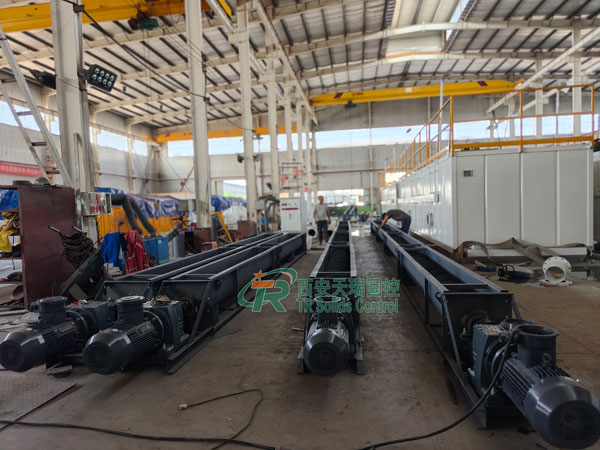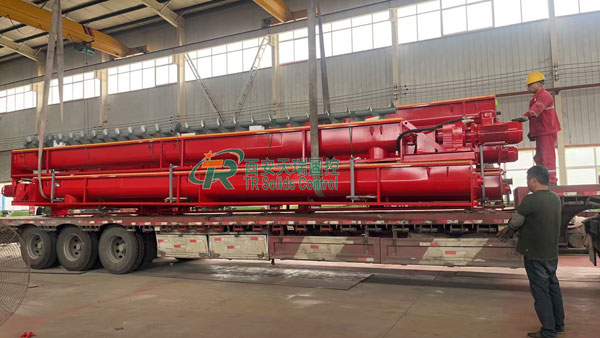In oil and gas drilling operations, screw conveyors are a key component of drilling mud equipment, primarily used for transporting drill cuttings, waste materials, and drilling mud. TR Solids Control will now provide a comprehensive analysis of screw conveyors for drill cuttings transport.
Screw conveyors (also known as "augers") are key connecting devices between the solids control system and the waste treatment system in oil and gas drilling. They are used to continuously transport drill cuttings discharged from solids control equipment such as shale shakers, desanders, and desilters to subsequent processing devices (such as drill cuttings dryers, centrifuges, or storage areas) to achieve "zero-landing" treatment of drilling waste.

Core mechanism: Utilizing rotating helical blades to propel materials axially within a U-shaped trough.
Power transmission: Motor → Reducer → Screw shaft → Rotation of screw blades
Conveying process: Drill cuttings enter from the feed inlet → are propelled forward by rotating blades → are discharged from the outlet → proceed to the next processing stage.
Applicable materials: Primarily used for conveying relatively dry drill cuttings (such as drill cuttings produced from oil-based drilling mud), with a moisture content generally controlled below 25%.
| Core components | Functions and features |
| U-shaped channel | To support materials and prevent leakage, 5-8mm thick steel plates are typically used, and the inner walls can be coated with a wear-resistant coating. |
| spiral blade | Key conveying elements, common forms: - Solid type: Used for drying small particulate materials - Belt type: Suitable for blocky or medium viscosity materials - Blade type: used for tough or compressible materials |
| Spiral shaft | It supports the blades and transmits torque; the material is mostly 45# steel or alloy steel. |
| Drive unit | Motor (usually explosion-proof) + speed reducer, power determined by the conveying capacity (7.5-30kW) |
| Feed/Discharge port | Flange connection facilitates interfacing with other equipment. |
| Cover plate | Sealed tank to prevent dust leakage, with inspection port. |
Special design:
Most adopt a segmented design (each segment approximately 3-4 meters) for easy transportation and replacement.
Some models feature a shaftless spiral design, offering strong anti-winding capabilities and making them suitable for conveying viscous materials.
Screw conveyor parameters
Delivery capacity: 10-50 m³/h (selected according to drilling scale)
Spiral diameter: Commonly used 200-500mm (must be ≥ 10 times the maximum particle size)
Screw speed: 15-60 rpm (variable frequency adjustable to prevent material splashing)
Conveying angle: ≤20° (optimal 5-15°), exceeding this angle requires reducing conveying efficiency.
Power: Determined based on transmission capacity and distance; standard configuration 7.5-22kW
Material: Q235-A (standard type) or 304/316L (corrosion resistant type)
Material properties:
Oil-based drilling mud cuttings: Standard auger cuttings are preferred.
High-viscosity, easily entangled materials: consider shaftless spirals
Corrosive materials: Use stainless steel or a special coating.
Wear-resistant and sealing design
The helical blades are made of wear-resistant materials (such as high-chromium alloys) to extend their service life.
The fully enclosed conveyor structure reduces dust leakage, protecting the environment and ensuring the safety of operators.
Installation conditions:
Space constraints: Screw conveyors have a small footprint and are suitable for compact well site environments.
Connection method with solid waste control equipment: Typically arranged parallel to the bottom of the vibrating screen.
Key points for selection:
Select based on drill cuttings characteristics:
Oil-based drilling mud cuttings: Standard U-shaped auger with shaft (recommended diameter 300-400mm)
Water-based drilling mud with high water content: Consider shaftless screw conveyors or scraper conveyors.
Key principles for parameter determination:
The spiral diameter D is ≥ 10 times the maximum particle size (≥ 4 times if there are few large particles).
Delivery capacity: Cuttings production rate at maximum drilling displacement (considering a safety factor of 1.2-1.5).
Equipment selection:
Motor: Explosion-proof (ExdⅡBT4), protection rating IP55
When used with a dryer, the screw conveyor capacity should be matched with the dryer's processing capacity.

1️⃣ Solids Control System → Waste Treatment System Connection
Receives drill cuttings discharged from shale shaker, desander, and desilter.
The cuttings are then conveyed to a drill cuttings dryer or a vertical spin dryer for further processing.
Ensure seamless integration between the drilling fluid solids control system and the waste treatment system.
2️⃣ Drill cuttings dried/dehydrated and then transported
The low-moisture-content drill cuttings processed by the dryer are then transported to a collection bin or transport vehicle.
Achieving "zero-fall drill cuttings" environmentally friendly treatment, meeting modern drilling environmental protection requirements.
3️⃣ Multi-device collaborative application cases
Typical configuration:
Three screw conveyors (7m + 6m + 5m) are used in the drill cuttings drying system.
1 unit: Dryer feed conveyor
2 units: Waste output from the centrifuge
15 screw conveyors are used in the waste slurry treatment system for 3 drilling rigs.
1️⃣ Insufficient conveying capacity
Cause: Insufficient motor power; severe wear of the spiral blades; excessively high moisture content in the material (>30%).
Solution:
Select a motor with appropriate power (usually 10-20% higher than the calculated value).
Regularly inspect blade wear and replace them promptly.
Controlling the treatment effect of upstream solids control equipment reduces the water content of drill cuttings.
2️⃣ Material blockage
Cause:Uneven feeding, localized accumulation; excessive gap between blades and housing; excessive conveying angle (>20°).
Solution:
Ensure uniform feeding
Adjust the clearance between the blades and the casing (≤5mm)
Reduce the conveying angle or shorten the conveying distance
3️⃣ Motor overload
Cause:Material adhesion increases resistance; bearing damage increases operating resistance.
Solution:
Clean the inside of the equipment regularly to prevent materials from sticking together.
Replace the damaged bearing and ensure proper lubrication.

As a crucial component of oil and gas drilling mud systems, screw conveyors have become the preferred equipment for cuttings transportation due to their simple structure, high efficiency, stability, and environmentally friendly sealing features. Selecting the appropriate model and proper maintenance ensures seamless integration between the drilling solids control system and the waste disposal system, achieving the environmental goal of "no cuttings on the ground" and providing a solid guarantee for the efficient and environmentally friendly operation of modern drilling operations.

Address: No.2 Hu·ochang Rood, Yangling District, Xianyang City, Shaanxi Province, China
Tel: +86-13186019379
Wechat: 18509252400
Email: info@mudsolidscontrol.com
Contact: Mr.Li